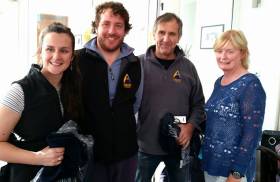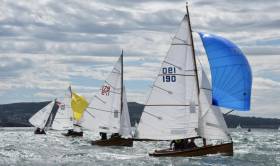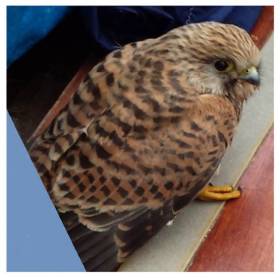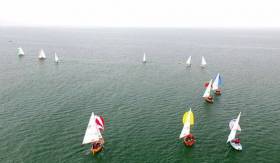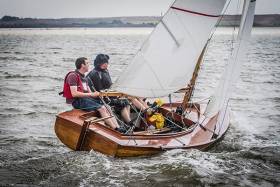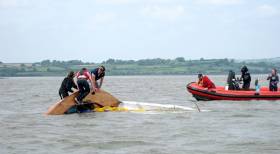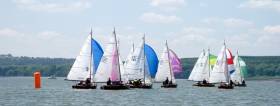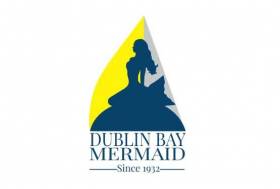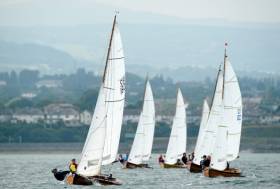Displaying items by tag: Mermaid
The annual Rush Regatta took place this weekend at Rush Sailing Club with 2 races planned for both Saturday the 3rd and Sunday the 4th of September. A very wet and windy Saturday morning saw 14 boats entered, busy rigging and getting ready for what was shaping up to be a very eventful day. OD Liam Dineen held a briefing at the club at 10am informing the Mermaid fleet that they would be doing a trapezoidal course, a change from the usual Olympic course normally used. This was to accommodate running cruiser and dinghy races all out on the same race zone. Conditions for the day were showing 18-24 knots and big waves to make for excellent surfing and high adrenaline, fast racing.
A ripping tide meant getting out to the course proved a challenge in itself but by 12:20 everyone was on the course and ready to race. With a cruisers race already in progress, the Mermaids got away on a clear start for race 1 at around 12:30pm on Saturday. Poor visibility and the challenge of a new trapezoidal course saw the Mermaids out of their comfort zone with a lot of pointing into the distance, squinting and generally very confused faces about! The left side of the beat going up the outer loop paid hugely and saw some boats making big gains on that first lap. The final mark 4 had cruisers coming in rounding to starboard and mermaids rounding to port, needless to say it was interesting! The full course was completed with first place going to Skerries boat 186, Gentoo helmed by Brian McNally. Second place went to Vincent Mc Cormack on 119, Three Chevrons from Foynes Yacht Club and third place to Frank Browne on Cara II also from Skerries. With concerns over the demanding conditions and a 2nd race possibly proving too much, the decision was made to cancel racing for the rest of the day and the fleet headed back in battered and bruised but very invigorated and looking forward to the next day’s racing.
Sunday saw very different conditions as Mermaiders wearing t-shirts and sunglasses rigged up in sunshine. With the forecast looking light and set to drop off during the day, everyone was keen to get launched and racing according to schedule. Again the tide proved challenging to get out to the course and following a short postponement Race 2 of the Regatta got underway with the familiar Olympic course being used. Local boat 123, Vee helmed by Jim Carthy banked hard right on the first beat with the majority of the fleet going left. The tactic paid off hugely with Vee gaining a massive lead as they rounded the first windward mark. As the race progressed the wind began dropping off and despite a wise decision by the Race Committee to shorten course, the fleet only barely managed to complete the final leg with the tide overpowering the breeze and boats just about managing to keep moving forward. A deserving first place went to 123, Vee. Skerries boat 186, Gentoo helmed by Brian Mc Nally took 2nd and 3rd place went to Vincent Mc Cormack on 119, Three Chevrons from Foynes Yacht Club.
Hopes for getting another race in on Sunday looked slim as the Mermaids just about managed to complete their first race before the wind dropped off altogether. A strengthening tide had people eyeing up their anchors and getting towlines ready for the trip home. The Committee boat however had other plans hoisting the W flag indicating a course layout change to Windward Leeward. As if by magic breeze started to fill in from Lambay Island and within 10 minutes the fleet were looking at very different conditions with a steady 10 knots of breeze and Mermaids whizzing around hungry for a second race. The Committee were quick to get underway once conditions were right and there was another clear start as Race 3 of the Regatta got underway. A huge pin-end bias on the start line saw Skerries boat 179 helmed by Martin O’Toole and Foynes boat, 119 Three Chevrons gaining a big advantage and port tacking the entire fleet. Overall however it was a very closely fought race and the leaderboard changed a lot. A gate option saw the majority of the fleet going for the starboard mark as a very strong tide meant left and middle was the only way to go heading for mark 1. Skerries boat 185, The Message helmed by Ross Galbraith had a fantastic race, calling all their tactics perfectly and gaining them the lead. Once secured they proved uncatchable for 119 Three Chevrons who came in a close second behind them and third place went to 123 Vee who also had a fantastic race on the day.
Consistent results of 2 seconds and a third saw first place overall at the Regatta going to visiting Foynes Yacht Club boat 119, Three Chevrons helmed by Vincent Mc Cormack with crew Roisin Mc Cormack and Michael Lynch. As the only boat to travel so far it was certainly worth the trip up! Second place overall went to Skerries Sailing Club boat 186, Gentoo helmed by Brian Mc Nally with crew Valerie Cronin and Colm Fitzpatrick and third place overall went to local boat 123, Vee helmed by Jim Carthy with crew Muriel and Paula Carthy. The Regatta cup for the boat that came first in Race 2 also went to Jim Carthy on 123, Vee. Well done to all involved!
Howth Yacht Club's Classic Boat Championships Finishes in Style for Mermaids & Howth 17s
The Howth Yacht Club hosted the Classic One-Design Regatta - incorporating the National Championships of the Dublin Bay Mermaid and Howth 17 Footer classes. Download Mermaid results below. Even before you could see them, the vapour of varnish bumbled over the hills and lowlands into Howth. Facebook updates from sailors on motorways passing shiny timber creations confirmed that the Mermaids were officially on tour. Some arrived under cover of darkness and were only noticed early on Thursday morning with a full dinghy pen. Little sailors, just starting out on their sailing careers, couldn't even see over the gunwhales of these big dinghies. They oohed and ahhed at boats made from "actual timber?"
Twenty-three Mermaids were weighed and plopped into Howth Harbour. Some of them had been here relatively recently (1953!) and wondered who had stolen Howth Sailing Club. HYC's Jedi, Neville Maguire was on hand with fellow Mermaid aficionados Gerry and Ian Sargent to poke and point and raise eyebrows at things called "Cleats".
Under the care of National Race Officer Scorie Walls, Thursday's racing started at a polite 1400. Keeping the Northside flag held high, "Azeezy" from Skerries did the business with two wins from three races. Not content with competing with eachother on the water, the Annual Mermaid Table Quiz followed rehydration. In a show of poor manners, a table made up almost entirely of Howth 17 Footers won. A prize was awarded for the best answer to "What is the capital of Mongolia?" "Don't know, but it's got a lot of vowels and sounds fierce foreign".
Two races for the Mermaids on Friday saw "Wild Wind" (Rush SC) and "Tiller Girl" (National YC) equal "Azeezy"'s daily tot of 6 points. The gap wasn't closing.
Howth history in the making was being mentioned all week before the old ladies of sailing, the Howth 17 Footers, put on their Friday night frocks and took to the water for a single race from the East Pier. For the first time in history, 18 boats were afloat and jockeying for position. The busy start line was made slightly more complex when the class was given a downwind/ spinnaker start in front of the East Pier, with boats gybing and tacking simultaneously as they jockied for position with a minute to go. Almost inevitably for the class, the girls began the bumping and grinding before the start signal and "Oona" went for "Rita" like a jealous girlfriend. "Rita’s” stick-man, Marcus Lynch, found himself with a clip around the ear from "Oona's" bowsprit and was forced to retire with injured planks, cracked frames and a split rudder. Turns out that "Oona" picked the wrong girl to shout at and she broke her bowsprit in the collision. And so the anticipated race with the full compliment of the world's oldest one-design racing keelboats never quite happened. The remaining seventeen boats crossed the line with spinnakers flying and more photographers clicking than at a Justin Bieber underwear collection launch. Head girl was "Deilginis" with "Aura" and "Hera" following in her tracks.
Saturday morning saw the Howth 17 Footers dressing up in their finest gowns and bonnets and gliding like debutants to the dancefloor. "Hera" lifted up her skirt and frightened the girls by winning by over two minutes. The brazen thing. She would have to have her cough softened! "Deilginis" took back control of the crowd in Race 3, trailed by "Gladys" sporting her 2016 Spring/Summer collection.
By the middle of the day, the wind had picked up, gusting over 30kts, and it was become hard for some to keep the bonnets atop. The ladies rolled down the run more like drunken maids than the elegant princesses which left the Harbour. Half of the fleet chose to remove their topsails but not before the paparazzi had caught them on video, in full swing...
The Mermaids were on the far side of the trapezoid course and only crossed the Howth 17s at the leeward mark and short beat to the finish. It was likely that some Mermaid sailors were checking their insurance when they saw the 17s approach! Top Mermaid of the day was "Vee" (Rush SC) with a 1st and 4th. "Wild Wind" and "Tiller Girl" produced some magic to close the gap to leader "Azeezy" but it wasn't to be enough to rein in the eventual Champions.
Back on the Howth 17 course, "Leila" and "Aura" sobered and took the last two races, and "Deilginis" was to take the 2016 title. Class Captain, Tom Houlihan, took the Handicap prize aboard his "Zaida".
As the last of the Howth 17 sailors were plucked from the moorings, the Mermaids had already already been craned out and packed up, setting the scene for a packed balcony in glorious sunshine. Rehydration once more!
170 sailors and their entourages filed into the club dining room to be fed, found, watered, awarded and clapped at. Champion Mermaid sailor Sam Shiels pronounced an epic acceptance speech. His Howth 17 opposite, Luke Massey, countered it with an example of brevity and raised the trophy aloft.
The next Classic One-Design Regatta will be held at Howth Yacht Club over the weekend of 10-12 August 2018.
Kestrel Races Aboard Dublin Bay Mermaid
As Dublin Bay Mermaid Week starts in Howth Yacht Club tomorrow, a Kestrel that landed in Dan Brennan's Mermaid, Aideen, writes about her experience at the front end of the Dun Laoghaire Fleet's special races around Dalkey Island on Sunday.
Interviewed after the race the Kestrel said “It has always been my ambition to sail in a traditional hand crafted wooden boat. I could land in a modern mass production boat any day of the week, but I wanted the real classic boat experience. I saw the beautiful five boat Mermaid fleet under spinnaker running towards Dalkey Island and couldn’t resist the temptation to try out a Mermaid. I was not disappointed, the Mermaid handled beautifully in the breeze. We were a bit behind when I landed aboard but the fleet came together at the back of the Island where the tide had started to flood and we worked our way into the lead by playing the shifts and getting into the strongest tide as we returned through Dalkey Sound. The breeze was very shifty with lots of holes as we passed through the Sound and beat back to Dun Laoghaire. My skipper did well but was outfoxed by former three times National Champion, Jonathan O’Rourke in Tiller Girl who was the 2016 winner of the Meg Mug.” The Mug is named after Meg of the Muglins and is raced for each year by the Mermaids around Dalkey Island.
She added (because she was a proper lady Kestrel and quite a rare bird) “While I really enjoyed the race I was disappointed that we did not win and I was upset to hear one of the crew, eight year old Charlie Martin say about me ‘this is the scariest thing that ever happened to me’. I have really caught the Mermaid bug and I am looking forward to dropping in on the Mermaid Nationals which are in Howth 4-8 August and maybe doing a few DBSC races. I appreciated the offer to have a few pints with the lads after the race but I had to fly home. ”
The Kestrel circumnavigated Dalkey Island in Aideen and flew away safely when back ashore in the National Yacht Club. Charlie enjoyed his first race and quickly recovered from his Kestrel scare.
A Kestrel is a small bird of prey (raptor) with a distinctive hovering flight which lives on a diet of small mammals. It is not a sea bird. Kestrels are amber listed due to concerns over declining numbers.
If you would like to join the discerning raptor in sailing in a DBSC Mermaid either as a crew or as a Mermaid owner, please contact the Mermaid Sailing Association, any member of the Mermaid fleet or Dan Brennan, Dun Laoghaire Mermaid Class Captain 087 -7985218. You will be most welcome.
This weekend saw a fantastic turnout of 18 Mermaids for the annual Skerries Regatta hosted by Skerries Sailing Club. The event which took place over Saturday the 23rd and Sunday the 24th of July gave the Dublin Bay Mermaid participants a great taste of what is to come at their upcoming National Championship event in Howth from the 4th – 7th of August. The racing was highly competitive with the leader board constantly changing across the 4, successfully completed races. Results are downloadable below.
Two races were successfully completed on the Saturday, which saw clear starts and light airs. A considerable wind shift after race 1 kept the race committee busy as the windward mark moved 40 degrees west and the increasing flow of tide meant tactics came very heavily into play for the second race of the day. Paddy Dillon on 131, Wild Wind was top of the leader board at the end of day 1 with a 1st and a 3rd but positions were very close and a discard that would come into effect the next day provided 4 races were completed meant it was still all to play for.
Competitors were very pleased to find a good breeze filling in on Sunday morning despite the windguru reading of 0-3 knots. As the day progressed the breeze increased making for excellent racing conditions in time for the 12 o’ clock start. Cruisers and a number of other classes including lasers and optimists made for a busy racing area and efficient 3 minute starts ensured racing got under way quickly. Race 3 made for a very interesting start line with a committee boat end bias and 18 boats all trying to get in! Boats banking middle and right up the beat paid off considerably and ultimately local boat 189 Azezzy helmed by Sam Shiels took 1st place. Similar to the day before, a big wind shift which was practically identical to the previous day saw the race course marks being moved and again stronger tide had to be taken into account. The sun also decided to come out and with a steady breeze and flat seas the 4th and final race of the regatta gave champagne sailing conditions and excellent racing.
The beats in race 4 pushed even the best tacticians to their limits seeing 90 degree headers and incredibly shifty conditions meaning the lead boat changed at almost every mark. Brian Mc Nally on 186 Gentoo took a deserving first place in the race with Sam Shiels who secured 2nd place hot on his heels. The final two legs of the race also saw the breeze pick up considerably meaning everyone suddenly went from heeling the boat to hiking to their limits! Such close racing showed just how well the Mermaids know their rules, there was lots of shouting, penalty turns and ‘threats’ but thankfully no protests!
With one discard applied, first place overall went to local boat Sam Shiels on 189, Azezzy who had two firsts and a second. Second place went to Brian Mc Nally on 186, Gentoo who had 2 seconds and a first and third place went to Paddy Dillon on 131, Wild Wind with a first and 2 thirds. The Red Island Perpetual Cup which is awarded to the first Skerries boat in the first race of the Regatta went to Frank Browne on 135, Cara II. All in all the regatta gave fantastic practice for the fleet before their National Championship which kicks off at Howth on Thursday the 4th of August.
Day two of the Munster Mermaid Championships at Foynes Yacht Club dawned to an overcast day however the forecasted sunshine broke through around 1100hrs and to the delight of the sailors brought with it plenty of wind. A south easterly gusty breeze of 15-18 knots shifting through 20 degrees resulted in a lot of mark moving and OOD Donal McCormack postponed racing until the wind settled down.
Race three got underway with a clear start. Early leaders Jim Carthy, Paula Carthy & Muriel Carthy on 123 Vee, Frank Browne, Frankie Brown & Oisín Finucane on 135 Cara II and local boat 161 Pearl with Noel McCormack, Mary McCormack & Cian McCormack went left on the course to gain over the rest of the fleet. At the windward mark 123 Vee had less than a boat length ahead of 135 Cara II in front of the crashing pack before a fast reach to the gybe mark.
By the top of second beat it was 123 Vee all the way as they built up a sizeable lead. Overall leader from day one 188 Innocence got buried at the start but fought back to fifth place by the second beat putting them just 0.25 points ahead of their nearest rival. At the last windward rounding 123 Vee had a comfortable lead and by the finish were clear winners. 188 Innocence climbed to fourth which gave them the overall lead. 119 Three Chevrons who had a good start but choose the less favoured side of the course on two beats came back on the third beat to take fifth in race three which held onto third place overall.
Thanks to the visiting boats from the Rush and Skerries. Looking forward to heading to Howth Yacht Club for the Dublin Bay Mermaid National Championships 4th to 7th August.
Champagne sailing conditions have often been bantered about in sailing reports but at Foynes Yacht Club for the Dublin Bay Mermaid Munster Championships this weekend you would think you were sailing in the Algarve!
Sailors were greeted this morning with a two hour postponement by OOD Liam Madden ably assisted by Donal McCormack and crew. It was a wise move, and as the morning progressed to the afternoon a southerly sea breeze filled in with glorious sunshine conditions. Racing got underway at 1300hrs with the competitors getting away to a clean start. Positions changed regularly but ultimately 188 Innocence, Darragh McCormack, Cathal McMahon & Mark McCormack were pushed hard by both 123 Vee, Jim Carthy, Muriel & Paula Carthy in second place and 119 Three Chevrons, Vincent McCormack, Roisín McCormack & Michael Lynch a very close third.
For race two the wind veered and dropped slightly. The OOD decided to reduce the length of the beat and move the gybe mark. Racing got underway at 1435hrs. After another clean start and due to the shorter beat, it was all to play for by the windward mark. Tight reaching continued throughout the remainder of the race and again the crew of 118 Innocence were to the fore, with 119 a close second and 135 Cara II, Frank Browne, Oisín Finucane and Frankie Browne finishing a very solid third.
The social side has already kicked off with crews enjoying drinks on the point looking out over Foynes Island waiting patiently for at dinner at about 1830 and the highlight of the night, the band Flog the Dog, a favourite of the Mermaid crews, at the sun soaked FYC. Racing will resume tomorrow at 1200hrs.
Dublin Bay Mermaid Gets a Makeover
The Dublin Bay Mermaids have been busy overhauling and freshening up the class image over the past few months. This work involves rebuilding the official website, launching a public Facebook page and Twitter account and creating an official brand for the class including a colour scheme and class logo. Yesterday, the new official class logo for the fleet was unveiled.
This is the first time the class has had an official logo which has received an extremely positive response from members. This new branding will be used to promote the fleet and create a recognisable class image moving forward. Work on the website is ongoing and the goal is to have the new site launched by early June, just in time for the start of an exciting and busy sailing season for the Mermaids.
The first main racing event for the class will be the Munster Championship at Foynes Yacht Club on the 4th and 5th of June. Two races are scheduled for Saturday the 4th of June with the first gun at 11am. One race is scheduled for Sunday the 5th with first gun at 12 noon. Music and entertainment will be provided at the club on Saturday evening with ‘Flog the Dog’ making a welcome return.
Howth Yacht Club to Stage Mermaid Champs
The Dublin Bay Mermaid Sailing Association hosts its 2016 Championships from Thursday 4th August to Sunday 7th August at Howth Yacht Club. Racing on Saturday 6th and Sunday 7th in the 17–foot clinker class will be in conjunction with the Howth 17 Championship.
The Leinster Championships will be hosted by Wexford Harbour Boat and Tennis Club on 9th and 10th July.
The class is working on a brand new website which in time for the upcoming sailing season.
Dublin Bay Mermaids Rally For 2016 Sailing Season
#Mermaid - Following new Mermaid Sailing Association (MSA) president Des Deane's call for participation, over 40 members packed the downstairs bar of Skerries Sailing Club on Friday 27 November for an "extremely productive" AGM.
A focus on the quality of racing for the fleet was discussed in depth, the outcome being that the existing format of one long race per day for the Mermaid’s week-long Nationals was overruled with a new format of two shorter races per day.
If conditions are favourable, then this new racing format would mean 12 races for Mermaiders at their next Nationals at Mayo Sailing Club from 30 July to 5 August 2016.
An invitation from Skerries Sailing Club to host the 2017 Championship was accepted enthusiastically, and Commodore Kieran Branagan, who was present on the night, shared his appreciation on the decision.
Still on the topic of improving racing quality, it was proposed that one of the fleet’s own members, Ruairi Grimes, now a qualified naval architect, would carry out an analysis of the Mermaid rudder design from the point of view of improving performance and stability. This was strongly welcomed at the meeting and will be followed up in the New Year.
All boats were weighed at the 2015 Nationals, with only one found lighter than the minimum weight of 415kg. Emphasis on quality and equipment checks was also discussed and highlighted for the upcoming sailing season, the calendar or which was decided on the night.
Aside from filling all committee positions, a number of new ideas were discussed on the night, including putting focus back on the fleet’s main ‘home’ clubs as well as actively following up on boats that are not used as often anymore.
Indeed, fears of "terminal decline" of what was once one of Ireland's preeminent dinghy classes have been overstated, according to the association.
"While numbers at events have been down in the past few years we still get some of the highest turnouts compared to other classes," said Roisin McCormack, new captain of the MSA. "Twenty-two boats for a week-long Nationals event is nothing to be ashamed of, and more importantly we are actively trying to improve the class and participation levels."
The MSA also noted that a number of new young helms who have joined the classic fleet in the past few years were in attendance on the night – with three new boat owners from Foynes Yacht Club this year alone, all qualifying as youth helms.
Following the success of February's prizegiving dinner, which attracted 100 guests, it was unanimously decided to host a similar event at Rush Sailing Club early in 2016.
This event will allow all members – old, new and prospective – to meet to discuss the upcoming racing schedule and plans for the future in the class in a more informal social setting. Details on this will be available in the New Year.


























